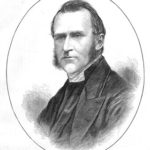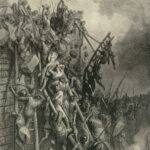Arminian and Baptist is a book about the history of Arminian theology in the General Baptist and Free Will Baptist tradition. It is written by J. Matthew Pinson, a Free Will Baptist, and the president of Welch College in Nashville, Tennessee.
I enjoyed the book, and learned a great deal about the history of Arminianism in the Baptist tradition. I recommend the book to Arminians and Calvinists alike, particularly to those who are interested in the history of Classical Arminianism. As a Wesleyan, I came away with a better understanding of the differences between Wesleyan Arminianism and Classical Arminianism (or Reformational Arminianism) and why these differences are important. I was sometimes irritated by the author’s passionate advocating of Classical Arminianism over Wesleyan Arminianism, however, he represents Wesleyanism fairly for the most part. Classical and Wesleyan Arminians have slightly different focuses as to what we think is important. These result in some minor in-house differences (which I’ll expand on at the end of the post).
The book starts with a history of Jacob Arminius and his theology. Arminius’ theology was thoroughly Reformed. He regarded Calvin highly. Arminius’ theology was “a development of Reformed theology rather than a departure from it.” In the time of Arminius there was also diversity on the doctrine of predestination in the Reformed church. Both contemporaries of Arminius and some of his Reformed precursors held to non-Calvinistic views of predestination. Pinson notes that “There was no consensus on the doctrine of predestination in the Dutch Reformed Church of Arminius’ time.” While Arminius was Reformed, he disagreed with Calvinistic predestination. He thought that Calvinism “inverted the Gospel” and that predestination did not properly focus on the work of Christ. “It was as though Christ and his work were an afterthought”.
Chapter 2 deals with the view of the Atonement in Arminius’ theology, where again Arminius remained Reformed. He was fully committed to the penal substitution (or satisfaction) view of the Atonement. This is the view that Jesus went to the cross in order to fulfill the demands of God’s justice. While God is merciful, he also is committed to justice. A price had to be paid for our sin. Jesus individually paid the price of each person’s sin. So God imputed our sin to Jesus, and he also imputes the righteousness of Jesus to each person who believes in faith. The penal substitution view is contrasted with the Moral Government view (developed by Remonstrant Hugo Grotius, and held by many Wesleyans). In this view Jesus suffered on behalf of humanity, but not individually for each person. As Governor, God was displeased with the sin of man. By accepting the suffering of Jesus, God is able to forgive those who believe, reconcile them to Himself, and maintain justice and order.
Chapter 3 gives a historical sketch of John Smyth and Thomas Helwys – the founders of the General Baptist movement. Both came from a Calvinistic Puritan background, and both adopted anti-Calvinist views. They spent time in the Netherlands, as did many Puritans. Around 1611 they separated because of differences. Smyth wanted to adapt the views of the Dutch Mennonites, including a rejection of original sin, and a focus on imparted righteousness. Helwys maintained an Augustinian view of original sin and held to imputed righteousness (Imputed righteousness is a forensic righteousness before God provided by Jesus. Imparted righteousness is where Jesus makes us more like himself).
Chapter 4 is an overview of Thomas Helwys’ treatise “A Short and Plain Proof”, which was a criticism of Calvinistic predestination. As all Arminians agree, Helwys argued that the atonement is for all – Jesus died for everyone. Helwys was particularly concerned about where evil came from, and that it could not have come from God. He argued that the original cause of the fall was Adam and Eve’s freedom, and that if it was instead decreed by God, then the fall was a deterministic necessity. Describing Calvinism and it’s impact on God’s character he wrote: “Can men make freedom and bondage in one and the same action, all in one man, and at the same time? How will men be able with any good conscience make things so contrary hang together?”
Chapter 5 is about the the General Baptist Thomas Grantham. Pinson contrasts Grantham’s theology with that of John Goodwin. Grantham was more conservative than Goodwin both doctrinally and politically. Whereas Goodwin argued for the Governmental atonement view, Grantham held to penal substitution. Grantham also didn’t care for the term “Arminian” because of the baggage that can be associated with the view.
Chapter 6 is about the theology of John Wesley, and the areas where Wesley differed from the Classical Arminian view. Wesley’s theology is described as an amalgamation of views that cannot be pigeonholed (I agree). Wesley’s theology is also described as more in the mold of John Goodwin and Hugo Grotius than that of Jacob Arminius. For example, Wesley rejected the idea of forensic justification, and called the view a cover for unrighteousness. “He (Wesley) found it difficult to conceive of a gospel that would allow a believer to commit sin with impunity because he has been imputed with the righteousness of Christ”. Pinson also argues that even though Wesley technically held to the satisfaction view of the atonement, he was influenced heavily by the governmental view: “[Wesley’s] theory of atonement relies on the logic of penal satisfaction but on the spirit of governmentalism.”
Chapter 7 is about the Free Will Baptist movement. It is described as confessional, Baptist, and Arminian. In contrast to most Baptist groups, FWBs have a high regard for historical Christianity and the creeds. Also in contrast to most other Baptist groups, FWBs believe that apostasy is possible. When apostasy occurs, it is permanent, and comes about because of a loss/rejection of faith in Christ, and not because of sin in the life of the believer. This is in contrast to most Baptists, who believe that apostasy is impossible (once saved always saved), and the Wesleyan view – who believe that a continued pattern of sin can also result in separation from God, but it’s still possible for the person to repent / be restored again.
I want to close with what I see as the key differences between Classical Arminianism and Wesleyan Arminianism. As noted earlier, Pinson is passionate about Classical Arminianism. Since I’m Wesleyan, I want to comment on these differences as seen from a Wesleyan perspective (for more details, see this post: <a href=”https://wesleyanarminian.wordpress.com/2009/12/08/a-comparison-of-wesleyanism-and-classical-arminianism/”>A Comparison of Wesleyanism and Classical Arminianism</a>).
Wesleyans tend to be less scholastic and systematic. An example of this is views of atonement (but it extends to other topics too). Classical Arminians always hold to penal substitution as the primary view of the Atonement. Wesleyans tend to hold to the governmental view, but also see value in the penal view, as well as the “Christus Victor” view (that Jesus defeated Satan at the cross). I personally lean to the penal substitution view, but I think all the views of the atonement add value and understanding to what Christ did for us on the cross, and even weak views (like the moral example theory) add to the tapestry.
Wesleyans are more ecumenical. We really like the saying “In essentials, unity; in non-essentials, liberty; in all things, charity.” We downplay doctrinal distinctness, and focus more on Christian unity. Even when reading about the history of Smyth and Helwys, I found myself identifying more with Smyth than Helwys. I admired his desire to find commonality with the Dutch Mennonites.
Wesleyans have more of a focus on the Holy Spirit. Another way of putting it is we are more Pietistic. We believe that the Holy Spirit fills us, speaks to us, and works in our lives. It’s the difference again between imputed and imparted righteousness. Wesleyans believe that not only are we forensically right before God, but as the Holy Spirit lives in us, he begins to change us deep inside, and we become more like Christ.
Lastly, Wesleyan theology tends to be more pastoral. We are interested in how the application of theology applies to our daily walk with God. I think all Arminian theology tends to be more pastoral than Calvinist theology. That’s because we all believe God is relational and loves us. But at the same time, Wesleyanism takes this a step further. Wesley himself was this way, and it’s why his theology was an amalgamation. Wesleyans are skeptical of theology that detracts from our daily walk with Christ.
——————————————————————————————————
Disclosure: I was provided a copy of the book, and agreed to write a review.
Original post can be found here





